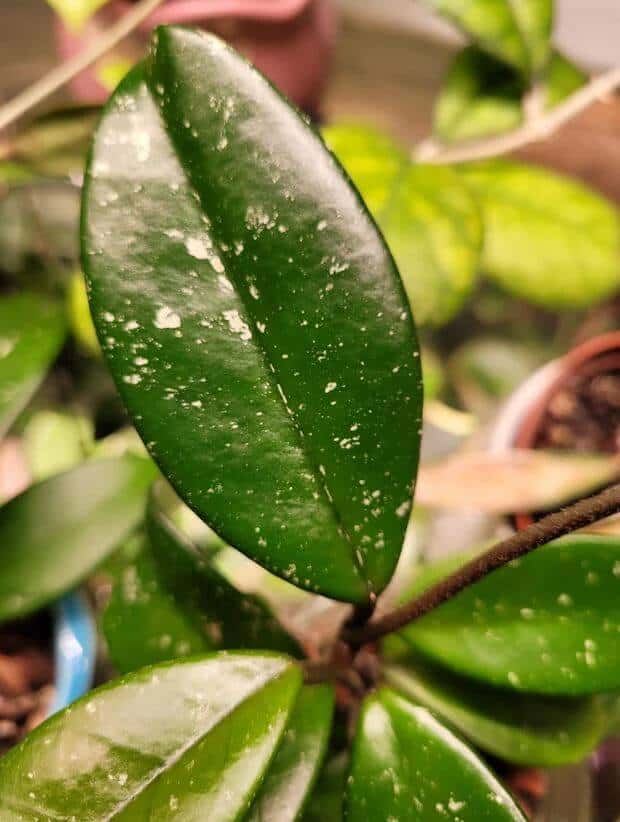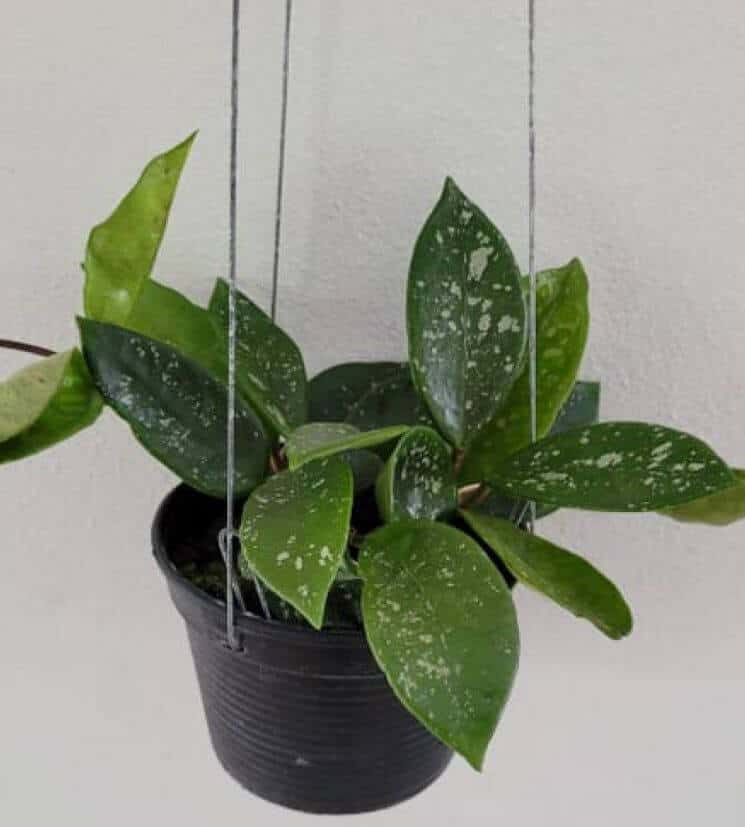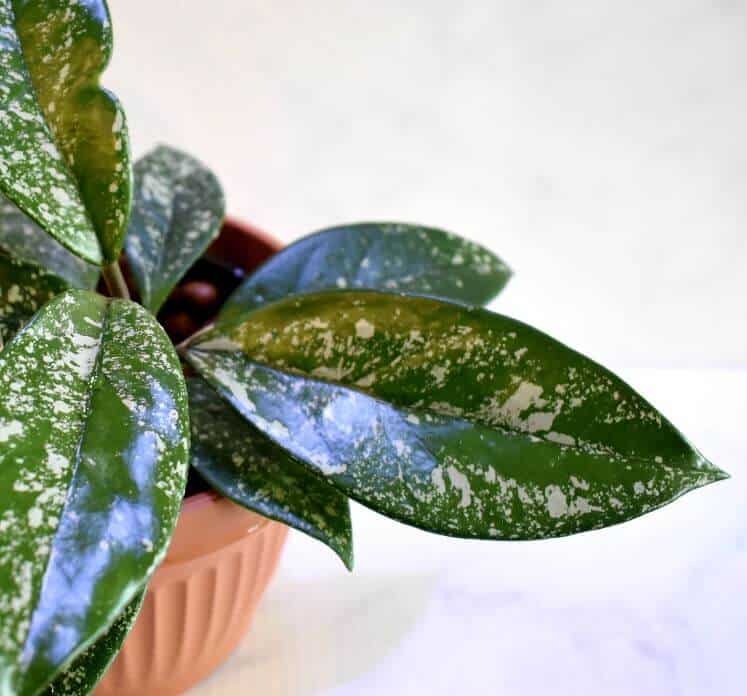Last Updated on April 17, 2023 by a Friendly Gardener
Belonging to the Apocynaceae family, the hoya carnosa includes numerous species estimated at more than 500 as well as even more hybrids. This species finds its native habitats in Australia and Eastern Asia. Popular names include the wax plant, the waxflower, the porcelain flower plant, the wax vine, and the waxy leafy plant. The “wax” in the popular names refers to the plant’s waxy foliage that can store water for hot seasons.
These plants are appreciated as excellent climbing species, so they do well when given support like trellises, poles, or structures. Flowers are star-shaped and fragrant. The hoya carnosa Stardust is a stunning plant to include in your indoor garden. Foliage features faint white or silvery specks and adorns thin, curly vines. The Hoya carnosa Stardust flower is a crème-colored blossom featuring a reddish crown. Vines can grow from twelve to twenty feet at maturity.
Hoya Carnosa Stardust Plant Care

Hoya carnosa plants appear to thrive when neglected. While they are not true succulents, their foliage does resemble succulent leaves and can store water. Most often cultivated in hanging baskets, they do well when grown as floor plants because as vining epiphytes they will readily cling to any support structures provided.
Soil
As epiphytes, Hoya carnosa plants need a very lightweight growing medium. Consider using a soilless potting mix blending two parts of it with one part of orchid bark or fine bark mix. Another option is a succulent or cactus soil mix mixed with pumice or perlite or an African violet soil mix again with perlite or bark added in. This will permit ample aeration of the growing medium meaning that more oxygen will arrive at the root system.
Light

The Hoya carnosa Stardust plant likes bright light. If the plant lacks adequate light, it will not produce blossoms and limit itself to only foliage which would be unfortunate as these blooms are quite impressive. Sunrooms, bright windows, and skylights are all good alternatives. They should not be overly exposed to harsh direct light as this can burn foliage or cause it to yellow. If your window position has harsh Southern exposure, consider using a sheer curtain to reduce harmful rays. Light is an important factor in flower production, so it must be generous.
Water
An important consideration in the cultivation of the Hoya carnosa Stardust is how much water it needs. These plants should not be overwatered. It’s a good idea to water this plant deeply until excess water drains from container drainage holes. Then wait until the soil medium has completely dried out before repeating the watering process. Leaves may pucker a bit if your plant becomes too thirsty. If foliage turns yellow and crispy, your plant has been without water for too long. Hoya plants can benefit from a month-long dry period in the winter, as this will stimulate blooming when spring arrives. After a month, normal care should resume.
Humidity
This is a plant that loves tropical humidity, so the more the better. You may want to consider using a space humidifier or pebble tray to increase humidity around the plant. Misting regularly will also aid your plant.
Temperature
The Hoya carnosa Stardust will do best in environmental temperatures measuring 65° to 80°F. Temperatures that drop below 60°F., especially for prolonged periods, can damage your plant. They can be cultivated outside in USDA hardiness zones 8 through 11.
Feeding

Use a diluted liquid well-balanced fertilizer for flowering plants when you water during the growing season. Avoid feeding your plant during the winter season. When blossoming begins, consider using a fertilizer with a higher phosphorous content to encourage flowering.
Pruning
Unwieldy, damaged, or dead vines can be trimmed as necessary. Avoid pruning during flowering. New flowers will continue to be produced from the same peduncles or spurs found on stem tips, so it’s important not to remove them. The plant’s peduncles should last the entire life of the plant.
Repotting a Hoya Carnosa Stardust Plant

Container-cultivated plants will probably need to be repotted every two to three years. The use of a terracotta or clay pot is ideal because it will aid in wicking away any excess moisture.
Hoya Stardust Propagation
Stem cuttings are the easiest method for hoya plant propagation. A vine section should have two to three leaf nodes, so trim a section and remove leaves at the cut end of the section. Leaves at tips should be maintained.
Cover the cut end of the vine cutting with rooting hormone and position it in a container with a soilless growing medium mixed with perlite. Water thoroughly and allow any excess water to drain out. It’s important that the growing medium is kept moist while you are waiting for roots to form.
Hoya Stardust Problems
The Hoya Stardust is generally resistant to pests, but you may occasionally find aphids, mealybugs, or spider mites have taken up residence, especially near blossoms. Use a water jet spray to remove pests and then treat your plant with insecticidal soap or a horticultural oil such as neem oil.
Overwatering can lead to root rot, so be careful to only water when the growing medium has dried out.
Never trim off peduncles as these are needed for flowering from year to year. Reddening leaves are an indication of excessive sunlight. Buds dropping may indicate a problem with your watering schedule.
When your Hoya Stardust plant flowers, resist the urge to do anything out of the ordinary. Let your Stardust bask in its flowering glory. Do keep in mind that a hoya plant usually needs a full two years before it will produce its first flowers and from four to eight growing seasons to reach maturity.
Hoya Carnosa Stardust Toxicity

The Hoya Stardust is not toxic to humans, although its milky sap may produce some skin irritation so gloves may be in order. Stems, foliage, and unripe fruits are not toxic to humans or animals including livestock, horses, and birds. If your pet ingests an immature fruit, it may upset its stomach.

